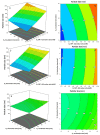Wasp venom peptide improves the proapoptotic activity of alendronate sodium in A549 lung cancer cells
- PMID: 35202419
- PMCID: PMC8872391
- DOI: 10.1371/journal.pone.0264093
Wasp venom peptide improves the proapoptotic activity of alendronate sodium in A549 lung cancer cells
Retraction in
-
Retraction: Wasp venom peptide improves the proapoptotic activity of alendronate sodium in A549 lung cancer cells.PLoS One. 2025 Aug 18;20(8):e0330467. doi: 10.1371/journal.pone.0330467. eCollection 2025. PLoS One. 2025. PMID: 40824844 Free PMC article. No abstract available.
Abstract
Background: Lung cancer in men and women is considered the leading cause for cancer-related mortality worldwide. Anti-cancer peptides represent a potential untapped reservoir of effective cancer therapy.
Methodology: Box-Behnken response surface design was applied for formulating Alendronate sodium (ALS)-mastoparan peptide (MP) nanoconjugates using Design-Expert software. The optimization process aimed at minimizing the size of the prepared ALS-MP nanoconjugates. ALS-MP nanoconjugates' particle size, encapsulation efficiency and the release profile were determined. Cytotoxicity, cell cycle, annexin V staining and caspase 3 analyses on A549 cells were carried out for the optimized formula.
Results: The results revealed that the optimized formula was of 134.91±5.1 nm particle size. The novel ALS-MP demonstrated the lowest IC50 (1.3 ± 0.34 μM) in comparison to ALS-Raw (37.6 ± 1.79 μM). Thus, the results indicated that when optimized ALS-MP nanoconjugate was used, the IC50 of ALS was also reduced by half. Cell cycle analysis demonstrated a significantly higher percentage of cells in the G2-M phase following the treatment with optimized ALS-MP nanoconjugates.
Conclusion: The optimized ALS-MP formula had significantly improved the parameters related to the cytotoxic activity towards A549 cells, compared to control, MP and ALS-Raw.
Conflict of interest statement
The authors declare no conflict of interest.
Figures







Similar articles
-
Prescription of Controlled Substances: Benefits and Risks.2025 Jul 6. In: StatPearls [Internet]. Treasure Island (FL): StatPearls Publishing; 2025 Jan–. 2025 Jul 6. In: StatPearls [Internet]. Treasure Island (FL): StatPearls Publishing; 2025 Jan–. PMID: 30726003 Free Books & Documents.
-
A rapid and systematic review of the clinical effectiveness and cost-effectiveness of paclitaxel, docetaxel, gemcitabine and vinorelbine in non-small-cell lung cancer.Health Technol Assess. 2001;5(32):1-195. doi: 10.3310/hta5320. Health Technol Assess. 2001. PMID: 12065068
-
Exploring the synergistic effects of metformin and doxorubicin loaded chitosan nanoparticles for A549 lung cancer therapy.Sci Rep. 2025 Jul 2;15(1):22657. doi: 10.1038/s41598-025-07996-2. Sci Rep. 2025. PMID: 40594871 Free PMC article.
-
A systematic review of the clinical effectiveness and cost-effectiveness of Pharmalgen® for the treatment of bee and wasp venom allergy.Health Technol Assess. 2012;16(12):III-IV, 1-110. doi: 10.3310/hta16120. Health Technol Assess. 2012. PMID: 22409877 Free PMC article.
-
A systematic review and economic evaluation of alendronate, etidronate, risedronate, raloxifene and teriparatide for the prevention and treatment of postmenopausal osteoporosis.Health Technol Assess. 2005 Jun;9(22):1-160. doi: 10.3310/hta9220. Health Technol Assess. 2005. PMID: 15929857
Cited by
-
Andrographolide nanophytosomes exhibit enhanced cellular delivery and pro-apoptotic activities in HepG2 liver cancer cells.Drug Deliv. 2023 Dec;30(1):2174209. doi: 10.1080/10717544.2023.2174209. Drug Deliv. 2023. PMID: 36762548 Free PMC article.
-
Natural Bacterial and Fungal Peptides as a Promising Treatment to Defeat Lung Cancer Cells.Molecules. 2023 May 27;28(11):4381. doi: 10.3390/molecules28114381. Molecules. 2023. PMID: 37298856 Free PMC article. Review.
-
Antimicrobial peptides as drugs with double response against Mycobacterium tuberculosis coinfections in lung cancer.Front Microbiol. 2023 Jun 2;14:1183247. doi: 10.3389/fmicb.2023.1183247. eCollection 2023. Front Microbiol. 2023. PMID: 37342560 Free PMC article. Review.
-
Targeting Dysregulated Ion Channels in Liver Tumors with Venom Peptides.Mol Cancer Ther. 2024 Feb 1;23(2):139-147. doi: 10.1158/1535-7163.MCT-23-0256. Mol Cancer Ther. 2024. PMID: 38015557 Free PMC article. Review.
-
Retraction: Wasp venom peptide improves the proapoptotic activity of alendronate sodium in A549 lung cancer cells.PLoS One. 2025 Aug 18;20(8):e0330467. doi: 10.1371/journal.pone.0330467. eCollection 2025. PLoS One. 2025. PMID: 40824844 Free PMC article. No abstract available.
References
-
- Balwan WK, Kour S. Lifestyle Diseases: The Link between Modern Lifestyle and Threat to Public Health. Saudi J Med Pharm Sci. 2021;7: 179–184. doi: 10.36348/sjmps.2021.v07i04.003 - DOI
Publication types
MeSH terms
Substances
LinkOut - more resources
Full Text Sources
Medical
Research Materials
Miscellaneous

